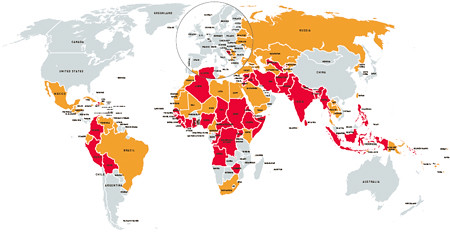There are many reasons for regarding the prevention of climate change as a moral imperitive. Drought, famine, disease, and decreased water quality will have a significant effect on quality of life, and are expected to kill 184 million people by 2100. But now we have another reason: war. According to a new report from International Alert, those environmental stresses will dramatically increase the risk of political destablisation or armed conflict in over 100 countries, covering more than half of the world's population. For example:
Consider Peru, said Smith. Its fresh water comes mostly from glacier meltwater. But by 2015 nearly all Peru's glaciers will have been removed by global warming and its 27 million people will nearly all lack fresh water. If Peru took action now, it could offset the impending crisis, he added. But the country has little experience of effective democracy, suffers occasional outbreaks of insurgency, and has border disputes with Chile and Ecuador. The result is likely to be 'chaos, conflict and mass migration'.The countries considered at risk are illustrated in the map below. Those with increased risk of armed conflict are in red, those with increased risk of political destablisation in orange:A different situation affects Bangladesh. Here climate-linked migration is already triggering violent conflict, says International Alert. Droughts in summer combined with worsening flooding in coastal zones, triggered by increasingly severe cyclones, are destroying farmland. Millions have already migrated to India, causing increasingly serious conflicts that are destined to worsen.
In our own backyard, we're looking at potential problems in Kiribati, Fiji, Tonga, Vanuatu, the Solomons, Papua New Guinea, and Timor-Leste. We will have to deal with these problems. I'd suggest that we start by trying to prevent them in the first place, rather than simply being the ambulance at the bottom of the cliff.






